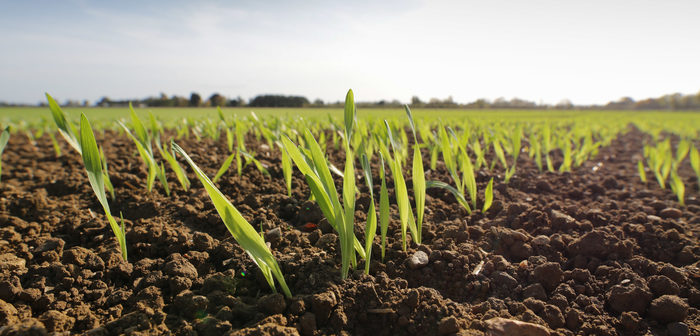Farmers could significantly reduce their phosphorus fertiliser bills and benefit the environment thanks to a novel product that converts unavailable phosphate into a crop-available form.
Many high calcium or high pH soils might appear to have adequate P indexes, but most of this essential nutrient is bound up as insoluble calcium phosphate and is not available to the crop, says Chris Martin, Agrovista’s head of soil.
“Phosphorus is critical for crop growth, playing a key role in cell biochemical functions and cell division. It is required in relatively large quantities during important plant development phases such as seed germination and rooting, as well as flowering and seed production.”
Applying bagged fertiliser can help meet demands, but this can be expensive and inefficient. “Depending on soil type and pH, as much as 90% of P applied in this form can become insoluble and locked up, often within days,” says Mr Martin.
“If you can make use of what’s already in the soil, you can make significant reductions in both inputs and costs. By applying Phosphorus Liberator, growers can free up significant amounts of P, reducing fertiliser bills and improving efficiency from applied phosphate fertilisers and manures.”
Phosphorus Liberator contains carboxylic acid, which solubilises calcium phosphate. This keeps the phosphate in solution, making it available for uptake through plant roots.
The product can be applied through a conventional sprayer pre-drilling or tank-mixed with a wide range of pre-emergence herbicides at rates tailored to soil P levels and crop need. It is effective over a wide temperature range, is biodegradable and is not classified as hazardous to the environment.
Indeed, Phosphorus Liberator could have significant environmental benefits, says Mr Martin. “Reducing phosphate pollution into water courses continues to be a key driver in the UK meeting Water Framework Directive obligations, and if the situation does not improve dramatically, legislation could very easily limit or even prevent phosphate applications across many fields throughout the UK.
“As the regulatory landscape changes in terms of fertiliser use, Phosphorus Liberator could become a go-to tool for those needing to unlock currently inaccessible nutrients within the soil, therefore reducing the reliance on traditional nutritional solutions.”
Phosphorus Liberator is part of the Agrovista Innovation Range of targeted bioscience products designed to help growers maximise the yield and quality of their crops.
Trial results
Assessments carried out on a range of crops this season have reinforced earlier work demonstrating the value of Phosphorus Liberator.
Last autumn, oilseed rape plots treated with Phosphorus Liberator at 10 l/ha had twice the root weight compared with those treated with DAP alone at 165 kg/ha, thanks to a 61% uplift in plant numbers and a 31% increase in individual plant root weights.
In winter wheat, a crop assessment conducted in Suffolk in January 2020 showed a dramatic increase in rooting when Phosphorus Liberator was applied compared with untreated. Root weight was up by 43% at the 5 l/ha rate and by 100% at the 10 l/ha rate.
The effect was still evident the following April. Tiller assessment showed the treated plots (5 l/ha and 10l/ha respectively) had 1.56 and 1.62 tillers per plant excluding the main stem, compared with 1.13 for the untreated. Where compound P had also been used, the figures were 1.84, 1.88 and 1.34 tillers respectively.
Spring beans showed an even bigger increase overall. Plant numbers rose by 69% and foliar and root weights by 133% and 122% respectively when treated with Phosphorus Liberator compared with untreated plots.
| OSR – crop assessment 24 October 2019 | |||
| DAP base fertiliser 165kg/ha | Phosphorus Liberator 10 l/ha* | % increase | |
| Total plants – average per m of row (g) | 11.75 | 18 | 61 |
| Total plant weight – as above (g) | 117 | 188 | 61 |
| Total root weight – as above (g) | 5.75 | 11.5 | 100 |
| Average root weight/plant (g) | 0.49 | 0.64 | 31 |
*Applied 17 September 2019 at cotyledon/one true leaf. Site: Hadingham, Norfolk
| Winter wheat – crop assessment 20 January 2020 | |||||
| Untreated | Phosphorus Liberator 5 l/ha | Phosphorus Liberator 10 l/ha | % increase at 5 l/ha | % increase at 10 l/ha | |
| Average plant weight (g) | 0.264 | 0.292 | 0.306 | 10.6 | 15.9 |
| Average root weight (g) | 0.07 | 0.10 | 0.14 | 42.8 | 100 |
*Applied 19 November 2019 peri/early post emergence (due to wet conditions). Site: Flixton, Suffolk
| Spring beans – plant development assessment | |||
| Untreated | Phosphorus Liberator 5 l/ha | % increase | |
| Foliage weight (g) | 21 | 49 | 133 |
| Root weight (g) | 18 | 40 | 122 |
| Plants/m2 | 13 | 22 | 69 |
*Applied pre-emergence of beans Site: Oxford
How to use Phosphorus Liberator
- Apply through conventional boom sprayer at traditional water volumes
- Widely tank-mixable with agrochemicals, including glyphosate and many pre-emergence herbicides
- Apply pre planting to early crop emergence
- Apply at 5 l/ha when used alongside phosphate fertilisers or organic manures
- Apply at 10 l/ha when applied alone.





